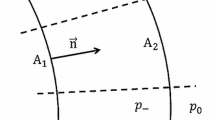Conclusions
We establish a connection between the Lyapunov exponent and SB ray methods which places a limit on the ability to make numerically deterministic or convergent predictions. When this limit is reached the ray fields are essentially random. One method, valid for ergodic straight ducts, is to represent the random ray field component by a field composed of randomly directed plane waves. We demonstrate that predictions made under this assumption have very similar bistatic RCS characteristics to those of an accurate modal solution.
Estimates of the Lyapunov exponent are directly related to average ray divergence and hence average ray intensity. For ergodic ray tracing this can be determined by the tracing of a single ray in order to place limits on the ability to achieve convergence. The computational cost of estimating the Lyapunov exponent is usually negligible compared to the cost of a full RCS prediction where all the rays on the entry plane must be traced.
Access this chapter
Tax calculation will be finalised at checkout
Purchases are for personal use only
Preview
Unable to display preview. Download preview PDF.
Similar content being viewed by others
References
G.A. Deschamps, September 1972, ‘Ray techniques in electromagnetics’, Invited paper, Proceedings of the IEEE, Vol. 60, No. 9.
A.J. Mackay, July 1988, ‘Chaos theory and first-order ray tracing in ducts’, IEE Electronics Letters, Vol. 34 No. 14, pp 1388–1389
A.J. Mackay, April 1998, ‘Chaos theory applied to first order ray tracing in ducts’, DERA Malvern, UK, report DERA/SN/R/TR980002/1.0, (available through DRIC)
A.J. Mackay, March 1999, ‘New representations of ray tracing, chaos theory and random waves in straight ducts’, DERA Malvern, UK, report DERA/S&P/RAD/CR990108/1.0, (available through DRIC)
A.J. Mackay, December 1999, ‘Application of chaos theory to ray tracing in ducts’, IEE Proceedings Radar, Sonar and Navigation, Vol 146, No 6, pp298–304
M.C. Gutzwiller, 1990, ‘Chaos in classical and quantum mechanics’, Springer Verlag, Interdisciplinary Applied Mathematics Series.
M. Berry, 1989, ‘Some quantum to classical asymptotics’, section 4 pp251, Les Houches 1989 Session LII, Chaos and quantum physics, North Holland publishing 1991.
E.J. Heller, 1989, ‘Wavepacket dynamics and quantum chaology’, section 9, pp548, Les Houches 1989 Session LII, Chaos and quantum physics, North Holland publishing 1991.
A.J. Lichtenberg and M.A. Lieberman, 1983, ‘Regular and stochastic motion’, Springer Verlag, Applied Mathematical Sciences 38.
P. Cvitanovic and B. Eckhardt, August 1989, ‘Periodic quantization of chaotic systems’, Physical Review Letters, Vol 63, No. 8, pp823–826
U. Smilansky, 1989, ‘Theory of chaotic scattering’, section 7 pp371, Les Houches 1989 Session LII, Chaos and quantum physics, North Holland publishing 1991
M. Berry, 1981, ‘Regularity and chaos in classical mechanics, illustrated by three deformations of a circular billiard’, Eur.J.Phys.2, pp91–102.
Author information
Authors and Affiliations
Rights and permissions
Copyright information
© 2002 Kluwer Academic Publishers
About this chapter
Cite this chapter
Mackay, A.J. (2002). An Application of Chaos Theory to the High Frequency RCS Prediction of Engine Ducts. In: Ultra-Wideband, Short-Pulse Electromagnetics 5. Springer, Boston, MA. https://doi.org/10.1007/0-306-47948-6_86
Download citation
DOI: https://doi.org/10.1007/0-306-47948-6_86
Publisher Name: Springer, Boston, MA
Print ISBN: 978-0-306-47338-8
Online ISBN: 978-0-306-47948-9
eBook Packages: Springer Book Archive




